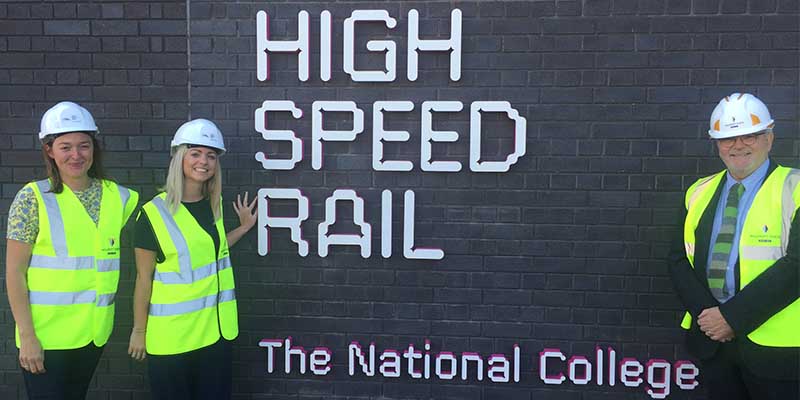
Bond Bryan Architects were at the National College for High Speed Rail in Birmingham yesterday to welcome Brumstar – a completely refurbished ‘Trans Manche Super Train’ generously donated by Alstom and Eurostar ready for the arrival of students next month.
Designed by Bond Bryan Architects – in partnership with Birmingham City Council, HS2 Ltd and major contractor, Willmott Dixon – the £22m facility is the first major National College development in the country. Bond Bryan worked closely with the client from the outset, to develop a strategic brief for both the Birmingham and Doncaster sites.
Bond Bryan Director John Lee, and Associate Director Steve Maslin, worked with the client team to produce a detailed brief from which the two ‘sibling’ projects emerged – one College in two locations.
The design brief and overall priority was to create a building which generates a revived sense of excitement around the rail industry and would attract the next generation of engineers.
The rail college represents the first “physical build” of the HS2 programme, delivering “on time and to budget”; this sets a great example for the country’s largest and most significant infrastructure project.
Internally, a large central atrium spine connects three floors of flexible-learning spaces and creates an opportunity for break-out, collaboration and social interaction. A vibrant double-height entrance space provides a public-facing café to encourage prospective students and interested members of the wider community to discover more about the opportunities the college offers and to re-engage with Birmingham’s – perhaps ‘lost’ – connection to trains and rail travel. These spaces all benefit from direct views into the main workshop, complete with its own full-size power car, this strong visual connectivity to the main engineering ‘showpiece’ reinforces the focus of the college as a national and pioneering centre of excellence for rail engineering.
Externally, the three-storey, 5,700 square metre building provides a ‘shop window’ to the passing traffic on Birmingham’s busy A4540 inner ring road, offering a direct view into the principal workshop and external training area. The projecting second floor creates a canopy over the main entrance and forms a pedestrian gateway through the site, linking the building to a reinvigorated Digbeth Branch Canal and opens walking routes to the nearby Aston University Campus and the wider city beyond.
The site itself, within Birmingham’s former industrial heartland, was previously occupied by a large metal works foundry – specialising in the production of bronze and brass extrusions throughout the height of the industrial revolution. Glass-making was also a prevalent industry in the area for centuries and, as such, the building design utilises these two main materials in its outward expression. Conceived as two intersecting volumes – one glass, one extruded bronze cladding- the building design embraces simple, understated and elegant industrial workplace design: the architectural vision was to create a building which embodies not only both the heritage and the future of rail engineering, but is also deeply connected to its local context.
The Birmingham Campus is specifically geared towards delivering the digital components of the college curriculum, so the idea of expressing the lines and dots of digital binary codes formed a key part of the elevational treatment from day one. Perforated cladding panels and linear fins, which wrap around the building, capture this ‘digital’ character but also reference some of the more historical parts of rail heritage. The repetition, rhythm and proportion of tracks and railway sleepers feature heavily in the vertical shading fins which enclose the building – creating ever-changing layers of light and shadow as one moves around the building – such that the façade always appears to be in “a state of motion”.
Bond Bryan are the foremost designers of advanced manufacturing and vocational learning buildings; Bond Bryan Director, John Lee explained: “The High Speed Rail College aims to provide specialist training within a stimulating environment, in which staff and students can develop the wide range of engineering, digital and commercial skills required to support major rail and infrastructure projects. The college, is a catalyst for national skills renewal and wider urban generation – it helps to position Birmingham at the centre of a 21st century industrial revolution.”
The National College for High Speed Rail will open its doors to students this September.
Bond Bryan Architects Team: John Lee, Steve Maslin, Fran Holloway, Jon Rigby, Paul Shaw, Adam Helliwell, Simon Creaney, Mick Heydon

